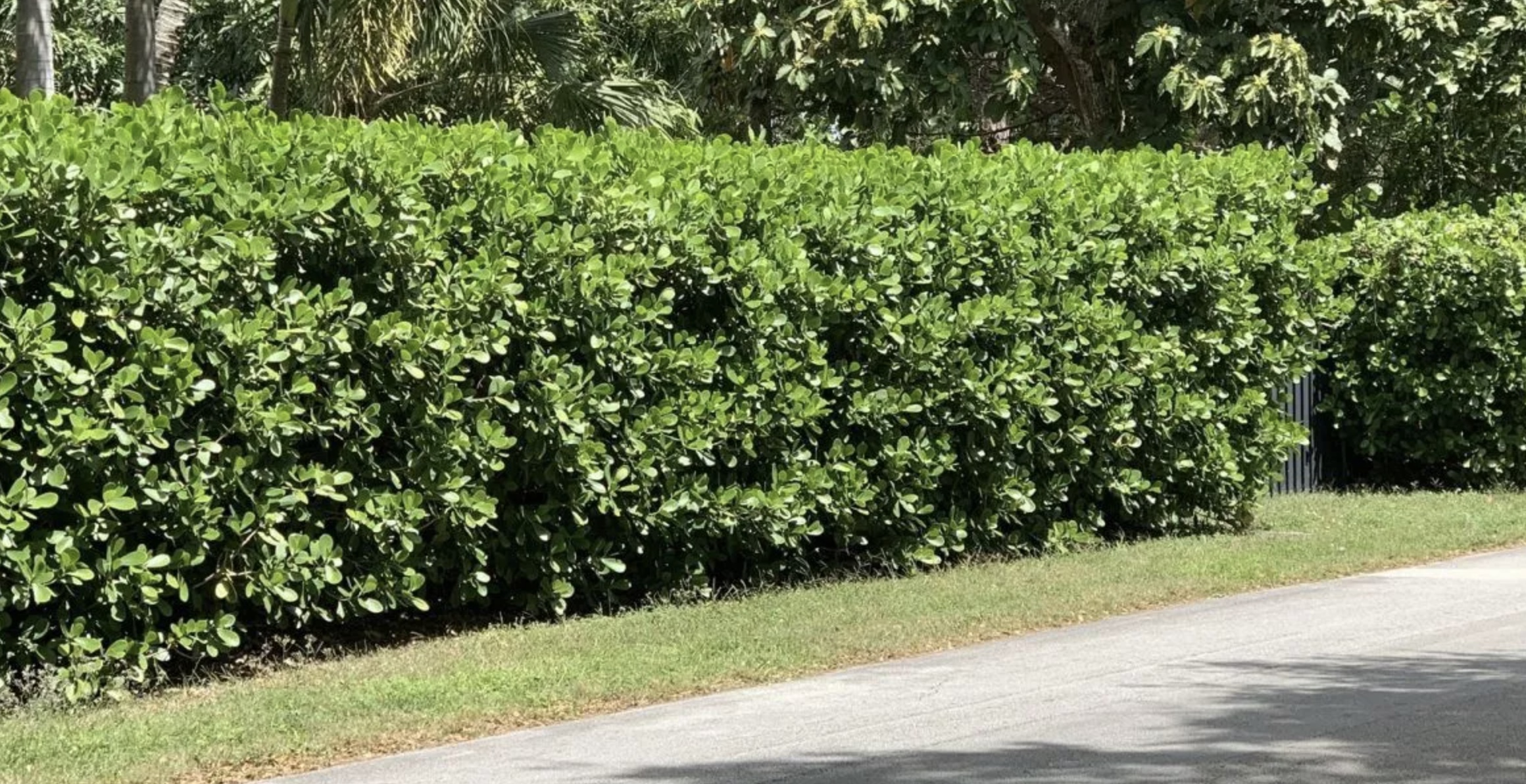Discover the allure of Clusia hedges, originating from the Caribbean and Central America, cherished for their robust, dark green leaves and hassle-free upkeep. Dive into the world of Clusia hedges and learn how they offer the perfect blend of privacy, aesthetics, and low maintenance for your outdoor sanctuary.
Key Takeaways:
- Clusia hedges are renowned for their sturdy, dark green foliage and minimal maintenance requirements, making them a popular choice for creating natural privacy screens.
- Clusia shrubs thrive in warm climates and can grow up to 15 feet tall, providing an effective barrier against intrusions.
- These hedges are drought-tolerant, low-maintenance, and adaptable to various soil types, making them a practical choice for privacy solutions.
Clusia is a wonderful foliage plant originating from the Caribbean and Central America. Because of its tough, dark green leaves and simple maintenance requirements, the hedge plant has gained popularity as a fence option. It will thrive in most homes. In the past few years, a Clusia fence has been a popular option.
The easy-care Clusia hedge does not pose challenges or problems even for novice gardeners. Today, however, we will provide some tips and instructions for how to make your hedges thrive and produce glossy evergreen foliage.
Get to know Clusia Hedges

As we said before, Clusia plants are native to tropical America. These branches grow horizontally, and the leaves are leather and thick. There are more than 150 Clusia species in the world.
The most popular option for a fence is Clusia guttifera or the Clusia hedge. This evergreen shrub is usually found in South Florida and California.
The oval evergreen leaves create a dense leafage, which is amazing for creating a private screen. Clusia shrubs, known for their dense foliage, offer an ideal natural privacy screen. The thick growth of these shrubs effectively blocks views from the outside, ensuring your backyard remains secluded.
What sets clusia shrubs apart is their ability to thrive in warm temperatures, even during the scorching summer season. This makes them perfect for creating a private oasis in your backyard, shielding you from the intense heat while providing a sense of shelter from strong winds.
With their densely-packed foliage, moderate growth rate, and leather leaves, clusia shrubs offer an impressive natural privacy screen. They require minimal maintenance, allowing you to enjoy your private space without the hassle of frequent pruning or upkeep. These low-maintenance shrubs are a great choice for those seeking privacy without sacrificing their time or energy.
In addition to their privacy-enhancing properties, clusia shrubs are also drought-tolerant. They can withstand dry conditions, making them an excellent option for regions with limited water availability. Whether you reside in a dry area or simply want a hassle-free privacy solution, clusia shrubs are up to the task.
The height of clusia hedges is worth noting as well. These shrubs can grow up to 15 feet tall, providing an impressive barrier against unwanted intrusions. Whether you wish to block the prying eyes of neighbors or create a serene retreat away from the bustling world, clusia shrubs offer the necessary height to fulfill your privacy needs.
Not only do clusia shrubs excel in functionality, but they also contribute to the aesthetic appeal of your landscape. The pleasant green color of their foliage blends seamlessly into various outdoor settings, enhancing the overall beauty of your backyard.
In conclusion, clusia shrubs offer a multitude of advantages for privacy screening. Their dense foliage, ability to withstand warm temperatures, low maintenance requirements, drought tolerance, impressive height, and aesthetic appeal make them the perfect choice for creating a private sanctuary in your outdoor space.”<
How fast does it grow?
So, how fast does Clusia guttifera and Clusia rosea grow? These two popular hedge species are moderately fast growers.
Clusia guttifera is a small leaf plant and grows up to 6 feet high or even taller. Trimming can keep the bushy shrub growing as an attractive privacy screen.
The Clusia rosea can grow up to 65 feet. Now that might sound like a lot, but with proper pruning, the tree can remain a large shrub.
These two options are popular in states like Florida as an evergreen hedge. Because of their densely-packed foliage, moderate growth rate, and leather leaves, they provide an ideal natural privacy screen for a warm backyard.
Why are clusia plants considered the best fast-growing trees for privacy?
Clusia plants are widely regarded as the best fast-growing trees for privacy due to a variety of factors. One of their key advantages is the ease with which they can be grown. Additionally, their leaves possess notable characteristics that contribute to their suitability for privacy purposes. Their thick and leathery nature, coupled with a waxy finish, not only enhances their visual appeal but also adds an extra layer of privacy to any garden setting.
Furthermore, the glossy, dark foliage of clusia plants imparts an elegant touch to the surroundings, making them a popular choice for privacy screening. In terms of practicality, clusia shrubs are particularly resilient when it comes to adverse conditions. They exhibit exceptional drought resistance, making them capable of thriving even in dry areas with limited water availability. They are also well adapted to withstand exposure to intense sunlight and high levels of salt in coastal regions.
The versatility of clusia shrubs further contributes to their status as the preferred option for privacy. These plants are highly adaptable to a variety of soil types, ensuring that they can be successfully grown in different locations. Additionally, clusia shrubs come in various sizes and shapes, providing flexibility for creating a privacy hedge that suits individual preferences. This versatility ensures that a carefully constructed clusia privacy hedge will endure for many years, providing an effective and aesthetically pleasing method of securing privacy in outdoor spaces.
In conclusion, clusia plants are renowned as the best fast-growing trees for privacy due to their ease of cultivation, the unique characteristics of their leaves, and their resilience to unfavorable conditions. The wide range of sizes and shapes clusia shrubs offer further enhances their appeal, making them an ideal choice for creating a long-lasting privacy hedge.
Why are clusia plants popular for hedges and privacy screens in South Florida?
Clusia plants are highly favored for hedges and privacy screens in South Florida due to their exceptional beauty and exceptional ability to flourish in this region. These plants are particularly sought after by homeowners in areas such as Miami and Broward. The popularity of clusia plants as a choice for hedges stems from their ability to create a stunning visual appeal while simultaneously allowing individuals to maintain their privacy. Additionally, clusia plants are known for their easy maintenance, making them a convenient and practical option for homeowners in South Florida.
How to care for Clusia hedge?
As we said before, this plant thrives in full sun and warm climates. But not let’s look into details on how to plant, where to plant, how to care, and everything you need for your Clusia fence.
Light requirements
Small leaf Clusia hedge, like the guttifera, are plants for full sun. Position them in your garden where they will get sun exposure for six to eight hours of the day. And you have to water them regularly so that they keep thriving in the heat and full sun.
This plant can also grow in partial shade.
Soil Requirements
This hedge plant needs fertile soil with excellent drainage to prosper. Clusia hedges are attractive and low-maintenance shrubs. They perform well in most soil types, but fertile soil is the best.
Yes, they can grow in poor soil conditions in coastal areas as well. But the most important part is to ensure the fertile ground is well-drained.
This is necessary to improve drainage and provide plenty of organic matter. When you add organic matter, it enhances the soil but also helps with retaining moisture.
But here is a fun fact. Because they are salt-tolerant, Clusia hedges can also grow in locations where the soil is not ideal. For example, many Clusia species thrive near the coast.
Watering needs
Glusia hedge grows best with regular watering. These hedges are drought tolerant, but regular irrigation helps keep the roots hydrated. During the first year, you need to water the shrubs regularly and allow the soil to partially dry out between watering.
Once the plant is established, you can water it when there are dry spells.
Generally speaking, similar to most types of hedges, Glusia hedges need to be well-watered. After dry periods, thoroughly water the hedgerow roots.
Provide enough water so that it sinks deep into the soil. While Clusia hedge plants can tolerate drought, they thrive when they get moisture.
Watering is most crucial in the first year after planting. During the first year, you might want to water at least twice a week until the plant is established.
Temperature and humidity
Now let’s talk about factors like temperature and humidity. They grow in USDA zones 10 and 11, meaning the minimum outdoor temperature should be between 30 and 40 Fahrenheit. Yet, the best minimum temperature for Clusia hedge is 50 Fahrenheit, which is usually the average temperature in Florida in winter.
These plants also enjoy high humidity of over 50%. This is why growing the hedge outdoors in a warm tropical region is always a good idea.
If you want to grow it as an indoor plant, average room temperatures are ideal. To increase humidity and moisture, just mist the leaves regularly. Water the indoor Clusia only when the soil partly dries.
How to plant it?
The best time to plant a new Clusia hedge is in the spring, just before the growing season. How to plant it? Here is your step-by-step guide.
- Start by digging holes at least 5 feet apart along the line of your new hedge
- Dig holes as deep as the Clusia root ball and three times as wide
- Now carefully ease your Clusia plant from its container and place it in the hole
- Fill the remaining space with organic rich-soil
- Pack the soil firmly so that your new shrub is sturdy in the ground
- Water the hedging shrub thoroughly for at least 15 minutes
- Place a two-inch layer of mulch around the base and ensure at least 4 inches of bare soil around the shrub’s main stem
- Water thoroughly for the next two weeks, and then two times per week until the shrubs get established
When it is time for regular watering, wait until the soil partly dries before watering. Check to see if the soil is dry and if there are no signs of moisture.
How to trim it?
Clusia guttifera hedges need light trimming to keep them in shape. You can use manual hedge shears or a power hedge trimmer. Make sure to remove any excess foliage. Trim them often to encourage healthy growth.
With appropriate trimming, you can train the plant to develop a square shape. If you want a full natural privacy screen, you should achieve dense and thick foliage from the ground to the top of the shrub.
Pests and diseases
Pests and diseases can affect the growth of your Clusia fence. Thrips and scale insects are the main pests that affect your Clusia guttifera or Clusia rosea growth.
Use an insecticidal soap or neem oil solution to prevent any pests around your tree. If you notice signs of scale insects, prune the infected branches, twigs, and leaves. Make sure to dispose of infected plant parts in the garbage. Do not compost them.
As for the diseases, these hedges are generally free from diseases. They should grow well and healthy as long as they are in full sun or partial shade.
